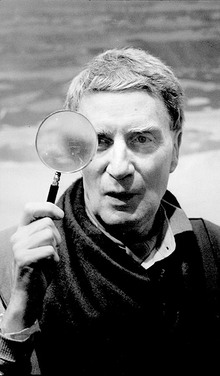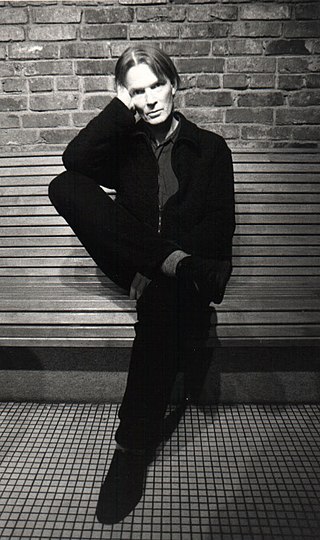Related Research Articles

Brion Gysin was a British-Canadian painter, writer, sound poet, performance artist and inventor of experimental devices.

The cut-up technique is an aleatory narrative technique in which a written text is cut up and rearranged to create a new text. The concept can be traced to the Dadaists of the 1920s, but it was developed and popularized in the 1950s and early 1960s, especially by writer William S. Burroughs. It has since been used in a wide variety of contexts.
Henri Chopin was a French avant-garde poet and musician.

Laura Phillips "Laurie" Anderson is an American avant-garde artist, musician and filmmaker whose work spans performance art, pop music, and multimedia projects. Initially trained in violin and sculpting, Anderson pursued a variety of performance art projects in New York during the 1970s, focusing particularly on language, technology, and visual imagery. She achieved unexpected commercial success when her song "O Superman" reached number two on the UK singles chart in 1981.

Anne Waldman is an American poet. Since the 1960s, Waldman has been an active member of the Outriders Poetry Project experimental poetry community as a writer, performer, collaborator, professor, editor, scholar, and cultural/political activist. She has also been connected to the Beat Generation poets.

James Dennis Carroll was an American author, poet, and punk musician. Carroll was best known for his 1978 autobiographical work The Basketball Diaries, which inspired a 1995 film of the same title that starred Leonardo DiCaprio as Carroll, and his 1980 song "People Who Died" with the Jim Carroll Band.
Sound poetry is an artistic form bridging literary and musical composition, in which the phonetic aspects of human speech are foregrounded instead of more conventional semantic and syntactic values; "verse without words". By definition, sound poetry is intended primarily for performance.

The Beat Hotel was a small, run-down hotel of 42 rooms at 9 Rue Gît-le-Cœur in the Latin Quarter of Paris, notable chiefly as a residence for members of the Beat poetry movement of the mid-20th century.

John Giorno was an American poet and performance artist. He founded the not-for-profit production company Giorno Poetry Systems and organized a number of early multimedia poetry experiments and events. Giorno's creative journey was marked by collaborations, groundbreaking initiatives, and a deep exploration of diverse art forms. He gained prominence through his association with pop art luminary Andy Warhol, sparking a creative partnership that propelled his career to new heights.
Something Else Press was founded by Dick Higgins in 1963. It published many important Intermedia texts and artworks by such Fluxus artists as Higgins, Ray Johnson, Alison Knowles, Allan Kaprow, George Brecht, Daniel Spoerri, Robert Filliou, Al Hansen, John Cage, Emmett Williams and by such important modernist figures as Gertrude Stein, Henry Cowell, and Bern Porter.
Barry Miles is an English author known for his participation in and writing on the subjects of the 1960s London underground and counterculture. He is the author of numerous books and his work has also regularly appeared in leftist newspapers such as The Guardian. In the 1960s, he was co-owner of the Indica Gallery and helped start the independent newspaper International Times.

Kenneth Goldsmith is an American poet and critic. He was the founding editor of UbuWeb and an artist-in-residence at the Center for Programs in Contemporary Writing (CPCW) at the University of Pennsylvania, where he taught. He was also a senior editor of PennSound at the University of Pennsylvania. He hosted a weekly radio show at WFMU from 1995 until June 2010. He published 32 books including ten books of poetry, notably Fidget (2000), Soliloquy (2001), Day (2003) and his American trilogy, The Weather (2005), Traffic (2007), and Sports (2008), 'Seven American Deaths and Disasters (2011), and 'Capital: New York Capital of the Twentieth Century (2015). He also was the author of three books of essays, Uncreative Writing: Managing Language in the Digital Age (2011), Wasting Time on The Internet (2016), and Duchamp Is My Lawyer: The Polemics, Pragmatics, and Poetics of UbuWeb (2020). In 2013, he was appointed the Museum of Modern Art's first poet laureate.

Ira Cohen was an American poet, publisher, photographer and filmmaker.

Dead City Radio is a musical album by Beat Generation author William S. Burroughs, released by Island Records in 1990. The CD is a collection of readings by Burroughs set to a broad range of musical compositions. It was produced by Hal Willner and Nelson Lyon, with musical accompaniment from John Cale, Donald Fagen, Lenny Pickett, Chris Stein, alternative rock band Sonic Youth, and the NBC Symphony Orchestra, among others. It was dedicated to "Keith Haring, at the Apocalypse."

Sinclair Beiles was a South African beat poet and editor for Maurice Girodias at the Olympia Press in Paris. He developed along with William S. Burroughs and Brion Gysin the cut-up technique of writing poetry and literature. He won the 1969 Ingrid Jonker Prize for poetry for his collection, Ashes of Experience.

Poetry in Motion is a 1982 Canadian documentary film directed by Ron Mann featuring contemporary North American poetry and music. Featured are some of the Black Mountain poets, Beats, minimalist poets, and avant-garde poets. It was released in theaters, later being distributed on VHS, LaserDisc, and DVD. An extended CD-ROM version was also released.

You're the Guy I Want to Share My Money With is a double album released in 1981. The album is a collaboration by Laurie Anderson, John Giorno and William S. Burroughs, recorded during their "Red Night" spoken word tour of 1981. Released through Giorno Poetry Systems Institute, the album was funded in part by grants from the National Endowment for the Arts and the New York State Council on the Arts. Most of Anderson's material came from her performance piece, United States, and live versions of some tracks, such as "It Was Up in the Mountains", would also be included in her later 4-LP release, United States Live. This was Anderson's first substantial album release, and she followed this in 1982 with her first full solo album, Big Science.
This is a bibliography of the works of William S. Burroughs.
Dial-A-Poem is a public poetry service established in 1968 by the late poet, artist and activist John Giorno after a phone conversation with William Burroughs. The service enabled members of the public to call Giorno Poetry Systems and to listen to a poem selected at random by writers including Amiri Baraka, William Burroughs, John Cage, Allen Ginsberg, Bobby Seale, Patti Smith and Anne Waldman. Installed first at the Architectural League of New York before moving to the Museum of Contemporary Art in Chicago for six weeks and then to the Museum of Modern Art in New York, the venture received widespread media attention. However, it was also known for its counter-cultural content – including polemics, Black Panther speeches, Buddhist mantras and queer love poetry – and following complaints and an investigation by the FBI, the service was shut down in 1970.
Dial-A-Poem Montreal was a phone-based service started in 1985 by Fortner Anderson, who was inspired by John Giorno's Dial-A-Poem and wanted to expand poetry beyond the limits of print. Listeners in Montreal could call 843-7636 (THE-POEM) anytime of the day to hear a poem. The service ran from September 1985 to July 1987 and ended because Anderson lacked the time and money needed for the project to continue. He produced the recordings himself and funded the project with his own money, sales of Clifford Duffy's first book Blue Dog Plus, individual sponsorships, and sponsorships by bookstores, local craftsmen, and schools. Participating bookstores included The Word Bookstore, Argo Bookshop, The Double Hook Book Shop, Steve Welch Books, and Véhicule Press. Anderson reported that in the first year, the service received about 200 phone calls a day and that over 150 poets contributed. He described the content of the poems as containing "themes of reaction to society's structures and structures, personal and social violence, topical issues of sex and gender, and people coping with alienation and the shifting ground of their own personalities."
References
- ↑ BENEDICTUS L, Sleeping on Job provides a Leg-Up, 2004, The Age
- ↑ Insight into Giorno's recordings for his electronic experiments, e.g. Suicide Sutra and Eating the Sky; downloadable at Giorno's UbuWeb Page
- ↑ discogs - The Dial-a-Poem Poets 1972 double LP
- ↑ discogs - Disconnected (the Dial-A-Poem Poets) 1974 double LP
- ↑ discogs - The Nova Convention 1979 double LP
- ↑ discogs You're the Guy I Want to Share My Money With 1981 double LP
- ↑ discogs - One World Party 1981 double LP
- ↑ discogs - I've Got a Right LP
- ↑ discogs Better an Old Demon Than a New God 1984 LP